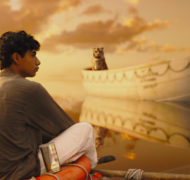Recapturing Innocence With Ang Lee
Blog / Produced by The High Calling
Recapturing Innocence
The sound of a baby’s laughter. A six year old’s wide-eyed wonder on Christmas morning. The moment you first believed. Who doesn’t want to relive innocence like that?
For Academy Award-winning director Ang Lee, recapturing innocence in life, in filmmaking, in the cinematic experience is at the heart of his film adaptation of Yann Martel’s best-selling novel, Life of Pi. Speaking to a group of journalists in New York City last month, Lee said the film is about what happens to a young boy’s innocence after the ship carrying his zoo-keeping family sinks and he’s set adrift on a lifeboat with a dangerous tiger.
The ocean becomes like a desert, Lee said. “It’s a test of his faith, his strength.”
Lee made the film in 3-D, not as a gimmick, but because this “new cinematic language” has the potential to restore the innocence of the theatrical experience for movie-goers. Many of us have become too cynical and sophisticated to have our imaginations’ expanded by 2-D, he said. “It’s harder to bring something like Pi’s zoo, the paradise, the innocence, where we can just believe in and explore our spiritual journey. It’s getting harder and then somebody invents some new ways to tell an old story.”
Technologies like 3-D open us up again and allow us to enter an imaginary world where we can “reach the truth that we’ve been hiding,” he said. “It’s a difficult challenge, because we don’t know too much about [the medium]. … The equipment is clumsy and the audience is still learning to take that in.”
For Lee as an artist, “experimenting with 3-D was like Pi facing the tiger.” It put him in the “God-zone” and kept him alert.
“I need total attention, focusing, and therefore I get the thrill that I’m leading life fully,” he said.
Storytelling Imitates Story
Inexperienced lead actor Suraj Sharma reminded crew members why they became filmmakers in the first place, Lee said. “We’ve been in the business for a long time. A lot of us can be jaded. ... We’re still doing what we do best, with passion and everything, but it can really get cynical, get tired. …That innocence is why I keep making different genres. I want to go to the same place. In the movie, that’s the zoo. You want to go back to that zoo, that paradise, that innocence.”
For his part, Sharma said working with Lee was not intimidating, but comforting. “You feel that if someone can trust you like the way he is, then you just give it everything you have and you trust him back, and everything will be okay.” The actor also came to identify with Pi’s journey as he faced the daunting task of making his first film. “I was a teenage Indian boy thrown into a situation where he never thought he’d be in, and there were things similar to tigers, challenges, and I just had to survive somehow.”
Sharma was acting not with a real tiger, but with a “blue man” who mimicked the tiger’s actions as a model for a computer-generated animal. Lee’s seasoning as a filmmaker gave him the confidence to entrust this challenge to a novice. He said his job was to make the teenager believe he was facing a dangerous beast and then offer guidance when Sharma’s technical inexperience caused him to falter.
“The beauty of a young talent is that when he believes, he believes. His whole body functions. Every molecule is coordinating toward the given situation. … Less talented people find it more difficult. But he’s good,” said Lee.
He’s good and he doesn’t know it. That guilelessness inspired the whole crew, Lee said.
Telling a Grand Story
Pi’s story is ultimately about storytelling, said screenwriter David Magee, and so the passing on of the narrative was thematically important. If the story was only told only from young Pi’s point of view, it would be communicated emotionally rather than reflectively, he said. “We wanted this to be the kind of big story, that I’m passing this on to you.”
Lee was also drawn to the interplay of the younger Pi and the older Pi in Martel’s story. Because of it, viewers are forced to either accept ambiguity or decide between a fantastical, heroic tale the older Pi retells and a brutal, perhaps more factually accurate alternative that will satisfy skeptics.
“Our goal in writing the film we did was to make sure that you could read the story or stories in any way you wanted to and it would be more of a reflection on your own belief system at the end. We don’t want to say, ‘Yeah, but the truth is it really was this way,’” said Magee.
For him, Pi surrenders his innocence when, near death, he and the tiger land on a strange island that is overrun with exotic foliage and creatures.
“It is a place that is nurturing and bountiful by day. It giveth. And at night, it’s a place of devouring and consuming and danger. Night taketh away,” said Magee. “Sometimes we called the island the godhead island because Pi’s journey over the course of the film is to have his presumptions stripped away, his comforts stripped away, and ultimately to reach a point where he’s at death and then he finds himself on that island and comes to know something about the nature of his relationship to God.”
The island saves Pi, but it also pushes him onward, Magee said.
For some viewers, Life of Pi will communicate a post-modern spirituality that says whatever story gets you through is true. I deal with that criticism in my review of the film at Image journal’s Good Letters blog.
For me, the conversation with these filmmakers was ultimately about what it means to mature as a human being and in one's vocational calling without being sidelined by cynicism and pain. It was about how art and process can feed each other, and about finding ways to reignite the flame of first love, or to keep it from burning out in the first place.
Life of Pi photos courtesy of 20th Century Fox Studios. Post by Christine A. Scheller.





